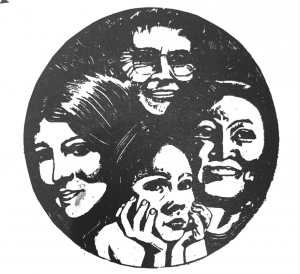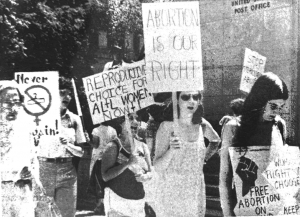By Julia Nasco

Reproductive Rights National Network Records, Box 1.
This exhibit brings together print advertisements from the Hartman Center for Sales, Advertising & Marketing History and images, information, publications, and literature on the reproductive rights movement and motherhood from the Sallie Bingham Center for Women’s History & Culture. It aims to highlight the contrasts between the reproductive rights movement in the 1950s through the 1980s and the depiction of women as mothers and the pressures of motherhood as shown in advertisements and society at the time.
How much harder was it for women to fight for control of their own bodies and the freedom to choose while surrounded by advertising images and literature that implied a women’s sole purpose was to be a mother?
From the 50s to the 80s, much of the external pressure for how women should lead their lives stemmed from print advertisements and prescriptive literature.
Print advertisements of the time often depicted women as subservient, sexualized, and ignorant, and showed them doing housework and taking care of their husbands and children. These advertisements were displayed strategically in magazines and newspapers, where women and men stumbled upon them. With the ubiquity of these ads came clear pressure that women should align with the images of the women they saw in the pages.
Prescriptive literature is a genre of writing that focuses on the social and cultural forces that shape the lives of women. Publications that fall into this category focus on “ideal womanhood.” Female readers could find a wealth of instruction on maintaining a home, finding a husband, keeping their husband happy, and being a good mother. The singular narrative of a submissive wife and mother was extremely harmful to any women who did not want to fill those roles or who did so unconventionally.
Combined, these sources acted as a barrier to the Reproductive Rights Movement, both for women who felt pressured to bear children and for men who were constantly reduced to seeing women in this sole position. Considering this, it is admirable that so many women were able to make way for real change during these four decades.

Reproductive Rights National Network Records, Box 1.
———
Within this exhibit, one can find: timelines of reproductive rights history through the 1980s and today; examples of literature and advertisements that enforced the ideal of motherhood; the feelings and experiences of feminists as well as the pro-choice movement and the pro-life movement response; and how the experience of women of color during the growth of the Reproductive Rights Movement was one of difficult decisions and abuse and a reclaiming of both race and gender.
Sections of this Exhibit:
- Reproductive Rights in History
- Pressure of Motherhood: Print Advertisements
- Pressure of Motherhood: Prescriptive Literature
- “You HAVE to be a Mother” / Opposition & Pro-Life Movement
- “I Don’t Want YOU to be a Mother” / Women of Color and Sterilization Abuse
- “I Don’t Want to be a Mother” / Feminists & Pro-Choice Movement
- Conclusion
- Bibliography